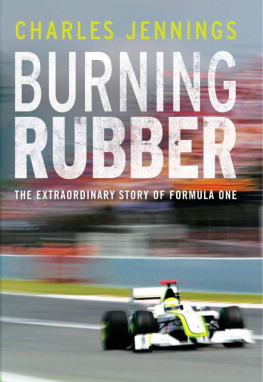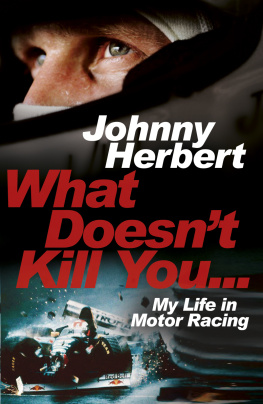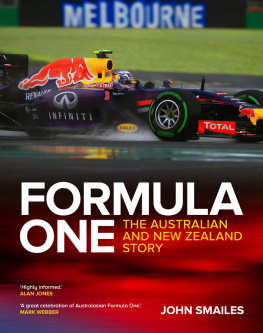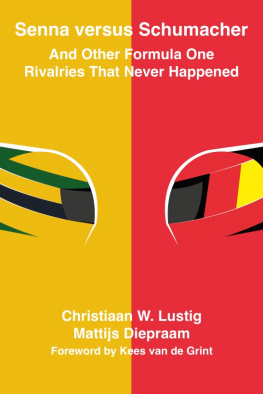BURNING RUBBER
CHARLES JENNINGS
BURNING RUBBER
THE EXTRAORDINARY STORY OF FORMULA ONE

First published in Great Britain in 2010 by
Quercus
21 Bloomsbury Square
London
WC1A 2NS
Copyright 2010 Charles Jennings
The moral right of Charles Jennings to be
identified as the author of this work has been
asserted in accordance with the Copyright,
Designs and Patents Act, 1988.
All rights reserved. No part of this publication
may be reproduced or transmitted in any form
or by any means, electronic or mechanical,
including photocopy, recording, or any
information storage and retrieval system,
without permission in writing from the publisher.
A CIP catalogue record for this book is available
from the British Library
ISBN 978 1 84916 092 6
10 9 8 7 6 5 4 3 2 1
Typeset by Ellipsis Books Ltd, Glasgow
Printed and bound in Great Britain by Clays Ltd, St Ives plc
For Susie
CONTENTS
The Age of Men
18941958
The Age of Brits
1959-76
The Age of Brains
197793
The Modern Age
19942009
THE AGE OF MEN 18941958
1
PRE-HISTORY
We are back at the dawn of time, the dawn of motor racing: the nineteenth century to be specific. This is an age when motor cars are built like baronial coaches, when drivers dress like arctic explorers, and when racetracks are nothing more than the common highway: loose mixtures of mud, light aggregate, boulders, manure and splintered timber. And whether you are in the vehicle or out of it, fear stalks the land.
Fear, or bewilderment. The motor car at the turn of the last century was so new, so outlandish, that no one much knew what to do with it under normal conditions, let alone in competition. Indeed, the very idea of getting a late-Victorian horseless carriage to last more than 20 miles without a breakdown of some sort required a leap of faith of, effectively, religious intensity. We are talking about belt-drive transmission, hot-tube ignition, solid rubber tyres, tiller steering. But the new breed of motorist tried, anyway.
And where there were motor cars, there were motor races. Although Gottlieb Daimler and Karl Benz had first perfected the concept of the petrol-engined automobile in Germany, it was the French who really took it to their hearts. Renault, Panhard et Levassor and Peugeot all started car production within a few years of the first workable Daimlers and Benzes. And the very first formally organised motoring contest was a French affair: the ParisRouen Trial of 1894, offering a prize of 5,000 francs to the driver of whichever vehicle performed best over the 78 miles separating the two cities.
Straightforward in principle, the race was actually won by an enormous De Dion steam tractor, fuelled by a stoker, steered by a driver and drawing its passengers behind it in a separately articulated carriage like a railway train. This was absolutely not what the organisers had in mind. They wanted one of the go-ahead new internal combustion engines to win. So demonstrating the kind of shameless expediency motor racings governing bodies were proudly to exercise on many subsequent occasions they promptly demoted the De Dion and awarded joint first prize to a proper, petrolengined Peugeot, which had managed an average speed of 11.5 mph, and a Panhard.
Steam cars aside, this set the trend. For the next few years, motor races were all city-to-city, along unmade roads, in conditions of appalling danger and discomfort, generally starting in Paris, and watched by tens of thousands of hysterical spectators these separated from the hurtling motor cars by nothing more than dust and thin air. They did Paris Amsterdam; ParisBerlin; ParisVienna. And, by 1903, most of the world was ready for the big one: a sprint from Paris to Madrid, boasting a field of more than 270 cars (and motorcycles) of wildly varying capabilities, several of which could reach 100 mph on the open road, and many of which weighed as much as a gun carriage.
Unsurprisingly, the French Government wanted to ban it. It was too long, they said, too dangerous, and there was no crowd control for the expected two million spectators along the route. They were absolutely right. At the end of the first day, two drivers, one riding mechanic and five spectators had been killed, while scores more were seriously injured. The race exacted a heavy toll in shattered limbs and wrecked vehicles. The event was abruptly stopped at Bordeaux, and those cars that could still be moved (only half of the original field) were towed off in shame by teams of horses. It was named The Race of Death. Marcel Renault, brother of the founder of the car company, was one of the fatalities. Clearly, a better way had to be found.
It first appeared in 1907, at Brooklands in Surrey. A rich car nut called Hugh Locke King built the worlds first dedicated racetrack, bankrupting himself in the process, but nonetheless establishing the concept of an enclosed, off-road circuit, where paying punters could enjoy an afternoons sport in reasonable comfort and safety. The fact that Brooklands a kind of Home Counties Indianapolis, monstrously simple, with banked turns linked by a couple of head-down straights would become outclassed and outdated almost as soon as it opened was neither here nor there. The real Indianapolis Speedway came soon after, in 1909, and was a huge hit. Le Mans public roads, closed off for the duration of the race was next to establish itself, followed, in the 1920s, by Monza, the Nrburgring and Monaco. The landscape was evolving.
As were the cars. Before anyone knew it, proper, modern, (racing) cars were starting to appear. If the Great War achieved anything at all, it was to speed up the development of light, efficient, power units all those aero engines which came into being and which would go on to influence automotive engine design in peace time. And the sports cars of the 1920s and 1930s testified to this: Bugattis, Alfa Romeos, Sunbeams, Fiats, and, later on, the authentically terrifying Mercedes and Auto Unions, all used the grammar and vocabulary by which we now understand the idea of the motor car. Unlike the pre-First World War horseless carriages, these machines were light, compact, low, and had a wheel at each corner. Their engines used clever, modern alloys and higher compression ratios. Camshafts multiplied, and lubrication systems got more efficient. Even their brakes worked, sometimes.
In fact, it was round about now that it started to become axiomatic that the only real competition cars were to be found in Continental Europe. Bentleys were all well and good for the Le Mans 24-hour Grand Prix dEndurance, where their massive indestructability garnered them five wins. But for anything shorter, quicker and more sinuous than Le Mans, you really needed a machine from France or Italy, with their engineering strength-in-depth and their twisty, challenging racetracks on which to learn real lessons about performance motor cars. When the first Championship series was organised (for constructors, only) in 1925, it consisted of four races (one at Indianopolis) and was won by Alfa Romeo. The next two years, it was Bugatti which took the honours. Henry Segrave bucked the trend by becoming the first Brit to win a Grand Prix in a British car in 1923, in a Sunbeam which was really a copy of a racing Fiat. Depressingly enough, this remained the only Grand Prix win by a British driver in a British car until well after the Second World War.
But what was a Grand Prix, anyway? The first motoring event to carry the name
Next page








